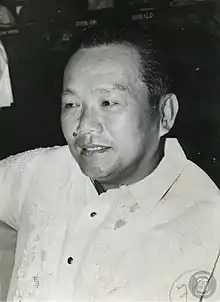Alejandro Almendras
Alejandro Durano Almendras (27 February 1919 – 4 August 1995) was a Filipino politician who served as a Senator of the Philippines. He was also governor of the then united Davao province.
Alejandro Almendras | |
|---|---|
 | |
| Member of the House of Representatives from Davao del Sur's 1st district | |
| In office June 30, 1992 – June 30, 1995 | |
| Preceded by | Juanito Camasura Jr. |
| Succeeded by | Alejandro Almendras Jr. |
| Governor of Davao del Sur | |
| In office 1986 – February 2, 1988 | |
| Succeeded by | Douglas Cagas |
| Member of the Regular Batasang Pambansa | |
| In office July 23, 1984 – March 25, 1986 Serving with Douglas Cagas | |
| Constituency | Davao del Sur |
| Member of the Interim Batasang Pambansa | |
| In office June 12, 1978 – June 5, 1984 | |
| Constituency | Region XI |
| Senator of the Philippines | |
| In office December 30, 1959 – September 23, 1972 | |
| Governor of Davao | |
| In office 1951–1958 | |
| Preceded by | Ricardo D. Miranda |
| Succeeded by | Vicente Duterte |
| Personal details | |
| Born | Alejandro Durano Almendras February 27, 1919 Danao, Cebu, Philippine Islands |
| Died | August 4, 1995 (aged 76) |
| Nationality | Filipino |
| Political party | Lakas–NUCD (1992–1995) |
| Other political affiliations | Kilusang Bagong Lipunan (1978–1986) Nacionalista (until 1978) |
| Spouse | Caridad Cabahug |
| Children | 7 |
| Alma mater | Far Eastern University |
| Occupation | Politician |
| Military service | |
| Allegiance | |
| Branch/service | Philippine Commonwealth Army |
| Years of service | 1941–1945 |
| Rank | Lieutenant colonel[1] |
| Unit | Philippine Army Air Corps (1941–1942) |
| Commands | 88th Infantry Regiment (Cebu Area Command) |
| Battles/wars | World War II |
Early life and education
Almendras was born in Danao, Cebu on February 27, 1919, to Paulo Almendras and Elisea Mercado Durano. He finished his secondary education studies at the Cebu Provincial High in 1938. He attended the Far Eastern University taking up aeronautical engineering as his college degree but his studies was interrupted in 1941 due to World War II. After the war, Almendras went back to his studies and attended Mindanao Colleges in Davao City.[2]
World War II
Almendras was enlisted with the Philippine Army Air Corps during the World War II. Following the surrender of the United States Army Forces in the Far East (USAFFE) to the Japanese Imperial Army, he went back to Cebu and served under the command of Col. James M. Cushing. At age 23, Almendras was named as commander of the 88th Infantry Regiment of the Cebu Area Command. After the war, Almendras was awarded the Outstanding Veteran in 1958 for his contribution for the country during the war.[3]
Political career
In 1951, Almendras who was a third-year law student at Mindanao Colleges at that time ran for governor of Davao province against incumbent Ricardo D. Miranda of Liberal Party, who took office in 1948 and the first elected governor since the aftermath of World War II. Almendras became the youngest governor in the country at that time and was re-elected again in 1955. Almendras served as governor until 1958, when he was succeeded by Vicente Duterte. The foreign correspondents’ Association of the Philippines conferred him with the "Outstanding Governor" award.[2][3]
For the 1959 senatorial election, Almendras was named as part of the senatorial slate of the Nacionalista Party of the then incumbent President Carlos P. Garcia. On May 8, 1959, months later after he was named part of the slate, Almendras was appointed as the first secretary of the Department of General Services by President Garcia.[3] In early February 1959, Almendras was named as the "Most Outstanding Cabinet Member” by the Confederation of Filipino Veterans.[2]
At the 1959 senatorial elections on November 10, Almendras was elected as senator taking up the eight and last slot for the position. He was re-elected in 1971,[3] and served as senator until 1972.[2] After the declaration of Martial Law by Ferdinand Marcos, Almendras became a Member of the Interim Batasang Pambansa representing Southern Mindanao or Region XI. He served the position from June 12, 1978, until June 5, 1984.[3]
Death and legacy
Almendras died on August 4, 1995, due to a lingering illness. The senators of the 10th Congress of the Philippines credited him for the passing of Republic Act 3018 which nationalized the rice and corn industry and the law that is responsible for the foundation of the Veterans Bank. Then house speaker, Jose de Venecia Jr. noted his role for the partition of Davao province which he said brought socio-economic development in area which was part of the former province.[4] Due to his work and the resulting province Almendras is known as the "Father of Davao".[5]
Personal life
Almendras was married to Caridad Cabahug of Borbon, Cebu with whom he had seven children.[2]
References
- "A Real War Hero, Col. Alejandro Almendras: Military Strategist". Davao Association USA, Inc. 9 May 2006. Retrieved 31 May 2016.
- "Senators Profile - Alejandro D. Almendras". Senate of the Philippines. Archived from the original on 2 May 2016. Retrieved 31 May 2016.
- "Senator Alejandro D. Almendras". The Freeman. 25 April 2014. Archived from the original on 2016-08-08. Retrieved 26 May 2016.
- "Senate, House pays homage to Almendras". Manila Standard. 9 August 1995. Retrieved 31 May 2016.
- Oaminal, Clarence Paul (17 September 2020). "Governor/Senator Alejandro Almendras, the Cebuano 'Father of Davao'". The Freeman. Retrieved 16 June 2021.